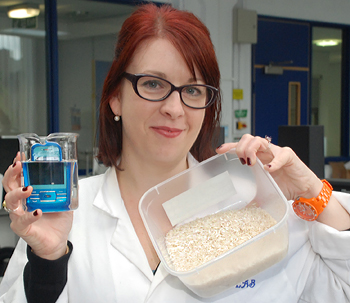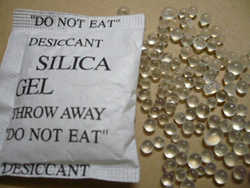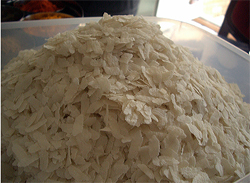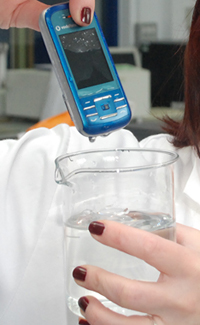Research shows rice is the answer for a wet mobile
Tue, 12 Nov 2013 13:12:00 GMT
When you accidentally drop your mobile into water, what do you do? Huddersfield scientists now have the answer.
 Science student Claire Boakes is pictured with her fascinating research into how rice flakes, among other things, can help revive seemingly broken mobile phones after they have been submerged in liquid.
Science student Claire Boakes is pictured with her fascinating research into how rice flakes, among other things, can help revive seemingly broken mobile phones after they have been submerged in liquid.
THOUSANDS have experienced that sinking feeling when they drop their precious mobile phone into the sink or into the toilet, spill their drink over it or accidentally put it through the wash. With data-packed mobiles increasingly central to people’s lives, salvage is vital. But what are the best methods? A University of Huddersfield student has carried out lab-based tests and come up with a Top Ten.
She also has some Top Tips. For example, when you buy goods such as shoes or handbags, or electronic items, make sure you hang on to the tiny bags of moisture-absorbing silica gel that are part of the packaging (pictured below). That way, you will have a free mobile phone first aid kit always to hand.
 This is because science student Claire Boakes has discovered that one of the best ways to revive a wet phone is by using the granules that are contained in five-gram silica gel pouches.
This is because science student Claire Boakes has discovered that one of the best ways to revive a wet phone is by using the granules that are contained in five-gram silica gel pouches.
However, various types of rice – which most people will have in the house – will also do a great job.
Claire, a mum of two from Golcar, had a career as a beauty therapist before deciding to study for a BSc degree in food, nutrition and health at the University of Huddersfield. Her goal is to become a science teacher, so she began to work with chemistry lecturer Dr Jeremy Hopwood, who manages the University’s secondary school and sixth form outreach programme.
 Dr Hopwood (pictured left) himself experienced disaster when he dropped his phone into the toilet while helping his four-year-old daughter.
Dr Hopwood (pictured left) himself experienced disaster when he dropped his phone into the toilet while helping his four-year-old daughter.
“I only hesitated slightly before retrieving the phone. I wiped it dry and then did all the things you shouldn’t do, such as turn it on!” he said. Later he dried it on a warm window sill and the phone works again, with a new battery. But the incident meant that Dr Hopwood began to investigate the best ways to dry a mobile and realised that this would make an ideal research project for Claire, who was working with him during the placement year that is built into her degree course.
A survey has shown that 31 per cent of mobile phone users have experienced water damage – with 47 per cent of them confessing to dropping the gadgets into the toilet. There are special drying-out products on the market, costing up to £15 a pack, and Claire will now research their effectiveness.
But she has compiled an initial report – Desiccation methods to save a wet mobile phone – which concentrates on the silica gels and different kinds of rice, plus techniques involving a vacuum cleaner or placing the phone in front of a lamp – a method which, says Claire, replicates conditions on a sunny window ledge. However, she warns against using a hairdryer, which might force water into the phone and cause even greater damage. The Top Ten desiccation methods are:
- Silica gel (5g)

- Silica gel (50g)
- Flaked Rice (pictured right)
- Lamp
- Basmati rice
- Long grain rice
- Pudding rice
- Paella rice
- Brown rice
- Vacuum cleaner
The results
It was found that five grams of silica gel were just as effective as a larger quantity, although both absorbed 100 per cent of the moisture. The granules must be dry before being placed in a box with the wet mobile – removing its battery first.
Various types of rice performed differently. After 24 hours, flaked rice was found to soak up 78 per cent of moisture and basmati did well, too, at 73 per cent. But brown rice managed to absorb just 44 per cent. A vacuum cleaner operated for 30 minutes sucked out 37 per cent.
In the early stages of her research, Claire simulated a mobile phone by using a piece of sponge placed on a shallow petri dish placed in a container. She could then measure precisely the amount of water that she pipetted into the sponge and the amount that was removed by the various methods.
 Eventually, Claire took the plunge with a genuine phone (as seen in the photo), after Dr Hopwood put out an appeal for old mobiles. She found that the average phone after being submerged for 30 seconds, shaken, battery removed and dried with a towel retains about one millilitre of water. That a standard 500g bag of basmati rice absorbs 80% of the water after 12 hours, 95% after 24 hours and 100% after 48 hours.
Eventually, Claire took the plunge with a genuine phone (as seen in the photo), after Dr Hopwood put out an appeal for old mobiles. She found that the average phone after being submerged for 30 seconds, shaken, battery removed and dried with a towel retains about one millilitre of water. That a standard 500g bag of basmati rice absorbs 80% of the water after 12 hours, 95% after 24 hours and 100% after 48 hours.
Claire concludes her report with this advice: “A supply of free silica gel packs could be stored away until needed. The silica gel was dried out before use and it would be recommended to empty the packs and dry out the gel in a low 60C oven before use, taking care not to contaminate anything consumable or setting the paper sachets alight. In the absence of a supply of silica gel, the phone should be left to dry out on a sunny window ledge or placed in an airtight container with either flaked or basmati rice.”
Dr Hopwood recommends basmati rice as this is easily available in the home as does not require drying out. He cautions against drying the gel in an oven while still in its paper pouch, which would catch fire.
“But if you have dry silica gel then that’s great. Otherwise rice is a very good alternative and is readily found in the home.”







